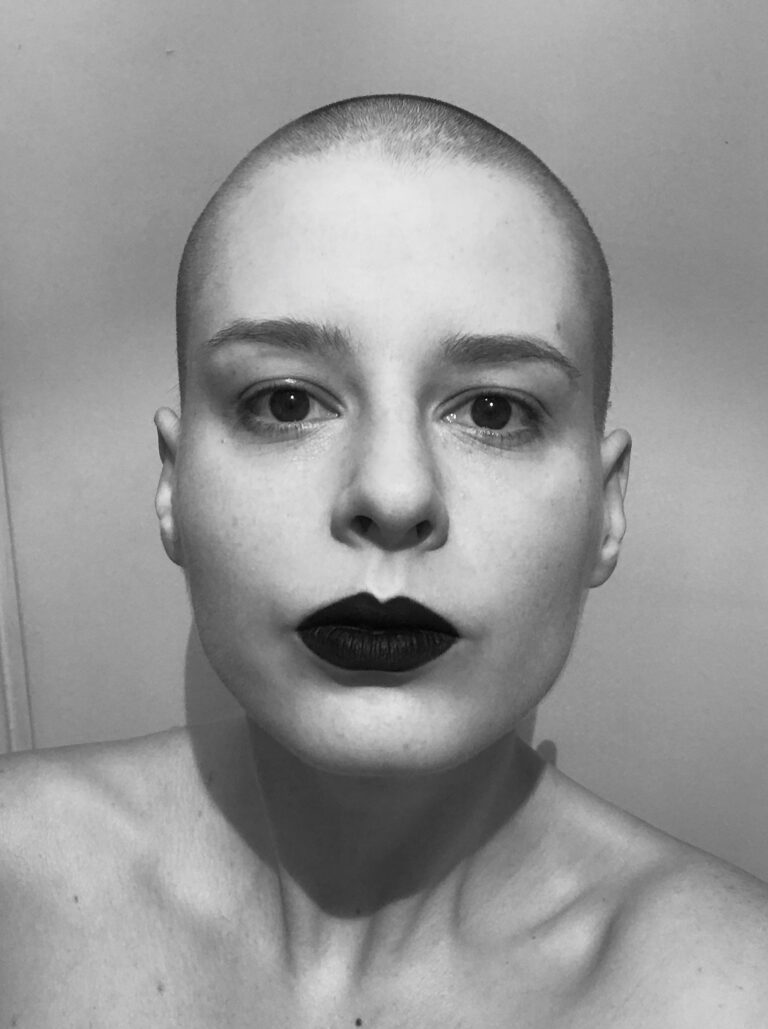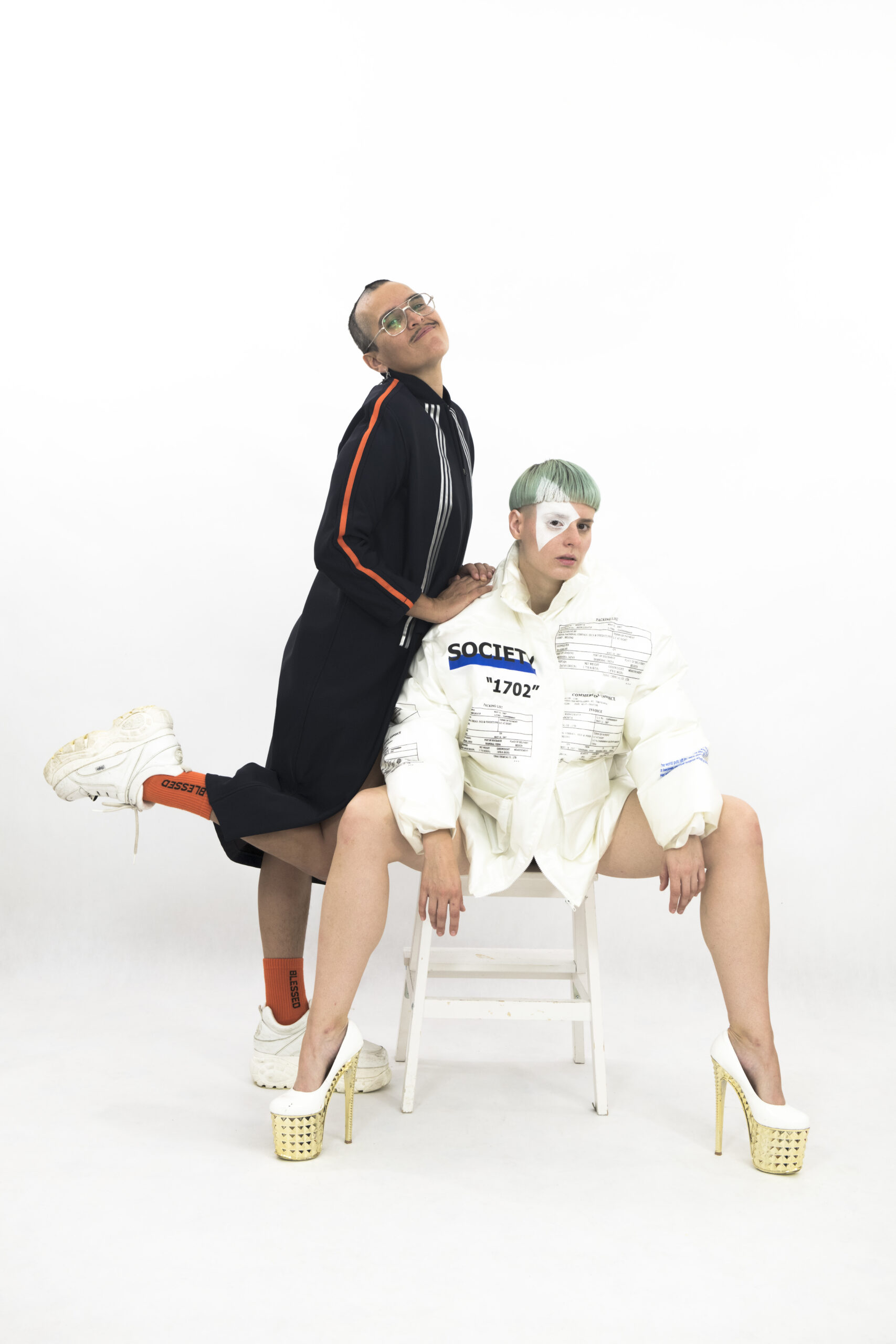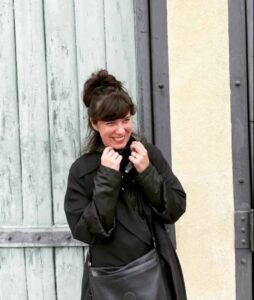Kle Mens

( Klementyna Stępniewska) – born 1985. Warsaw-based artist working in various media, such as painting, objects, video art. In her works she refers to Catholic motifs, looking for existential, feminist, sexual and political contexts. Winner of the main prize at the 12th edition of the Geppert Competition (2016), she graduated in painting from the Warsaw Academy of Fine Arts in 2014. The artist’s works arę in the collection of the National Museum in Gdansk.
There was something wrong with me from the beginning. I couldn’t find myself fitting in. I grew up in a world similar to that of The Handmaid’s Tale1, but in Catholic Poland. I am the child of a single mother, a schizophrenic, whose delusions were religious in nature. I grew up in a Catholic community with a sect-like structure. I was confronted with a wide and strictly enforced set of commands and prohibitions about my gender, body, sexuality and future. I couldn’t understand who I was and how I fit into the female roles I was assigned. Art is a way for me to find the answer to this question. With time, I realized that when I talk about myself, I am talking about a multitude of other people brought up in similar, but less intense conditions – in Catholic Poland.
The key is my body: I put it to different things and observe what happens to it, what comes out of it. In my artistic practice I impersonate different characters from the Catholic canon exploring their contexts: sexual, feminist and political. As a child I used to listen to stories about martyrs. They didn’t want to get married and therefore didn’t want to have sex, so they were often tortured in a sexual way, for example by having their breasts cut off. As an adult I asked questions about the role of religion in shaping my sexuality – I painted myself as St. Agatha with the breast cut off,2 as Kummernis3 – a saint to whom, according to legend, Jesus gave his face so she wouldn’t have to marry; the informal patron saint of genderfluid, non-binary and transgender people. I questioned my sexual identity – I have always not felt fully female. Commenting on the role of mother/uterus, I painted myself as Madonna Lactans4, I sculpted as St. Rita5. I did this because I have always felt that my body is appropriated and harmed by the Church, especially the Polish Church. At my first solo exhibition “Kato” at BWA in Tarnow in 2016, the All-Polish Youth protested to the tune of stadium chants shouting religious slogans. The footage6 of this event went viral on the Internet. People from Tarnów got involved in defending the exhibition; interestingly enough, both sides of the argument were religious.
Another exhibition of mine, “Blessed in Black”, which took place at the BWA in Zielona Góra in 2018, also caused controversy7. I played the role of the Black Madonna in it. The films Black Madonna weeping in white and red8, Litany9 and Trinity10 were made for it.
Art mixes with my personal life, work with my private life. These spheres intermingle, which can be awkward, but it’s my way of experiencing life. When you meet me or enter into a relationship with me, you have to reckon with the fact that you can become part of my work. You can see this in Pieta, Challenges of Adaptation11, or the Last Judgement12.
I have processed the influence of religion on my life and it is time to explore queer identity and sexuality more. Especially in the context of recent political events which have made me realise how important it is for me to be part of the queer community, I would like to invite the people closest to me in this group to collaborate with me and create a safe space for expression and experimentation. To ensure its visibility. The announcement of this project are these photos: 1314151617.
The text was written in collaboration with Anna Kowalska (2020).
1Margaret Atwood, Handmaid’s Tale, 1985, see: en.wikipedia.org/wiki/The_Handmaid%27s_Tale2Image: Kle Mens, St. Agatha with the breast cut off, 2015, oil on board, 54 x 27 cm. Courtesy of the artist. St. Agatha Agatha refused to marry and was committed to a brothel as punishment. During the torture, her breasts were cut off. She died a martyr's death. In iconography she is depicted with her breasts cut off or with her breasts on a tray.
3Image: Kle Mens, Kummernis, 2016, oil on board, 180 x 146 cm. Courtesy of the artist.
4Image: Kle Mens, Madonna Lactans, 2017, oil on board, 36 x 60 cm. Courtesy of the artist.
5Image: Kle Mens, St. Rita, 2017, polymer composite, edition of 15 casts, 30 x 30 x 18 cm. Courtesy of the artist. One of the miracles of St. Rita is that she prayed for the death of her two adult sons who wanted to commit murder. In iconography she is depicted with a stigmata on her forehead, which in many depictions resembles a vagina.
6See: youtu.be/IsSU4jg-9cs
7Kle Mens, Blessed in Black, 2018, exhibition, see: kle-mens.pl/portfolio/blessed-in-black-coming-soon
8Kle Mens, Black Madonna weeping in red and white, 2017, film, see: youtu.be/Ux1vLIbLYvs
9Kle Mens, Litany, film, 2017, see: youtu.be/GMRsQ-jTPwU In the film I play the Black Madonna saying the Litany of Loreto, popular in Europe, which in the Polish version has a different ending than everywhere else.
10Kle Mens, Trinity, 2017, film, see: youtu.be/uxbORX-vCNo This film is a paraphrase of Andrei Rublev's icon The Holy Trinity depicting God as three androgynous angels visiting Abraham.
11Kle Mens, Challenges of Adaptation, 2019, pencil on paper and gold carved frame, 53 x 38 cm. This is a drawing depicting role reversal - with a touch of dark humour. Here I draw on personal experiences of BDSM combined with an imagined intimate life of the Arnolfini couple. In the background is a copy of the 15th century painting The Martyrdom of St Agatha. The female character is played by me, the male character by my partner.
12Kle Mens, The Last Judgment, 2019, film, see: vimeo.com/341583312 It is a variation on Hans Memling's painting of the same title. It tells in an ironic way about the contemporary Polish socio-political situation. The male sphere of heaven is dominated by paramilitary symbols, flags, and religious figures. Hell is the hell of women. According to statistics, in Poland in nationalist protests the overwhelming majority of participants identify themselves as men, whereas in the protests of the Women's Strike (Pro-choice) the overwhelming majority of participants identify themselves as women. The realm of heaven and hell in the film is meant to reflect the two groups' perceptions of each other. Jesus, instead of sitting on a rainbow as in the original picture, sits on an arch in the colours of the Polish flag - this is to refer to the situation of the LGBT+ minority in Poland. Instead of the apostles traditionally surrounding Christ in this scene, I placed female martyrs to refer to their personal history.
13Image: Kle Mens, Kle Mens, Pepe Le Puke, 2020, digital photo. Courtesy of the artist.
14Image: Kle Mens, Kle Mens, Pepe Le Puke, Biczysko, 2020, digital photo. Courtesy of the artist.
15Image: Kle Mens, Kle Mens, Biczysko, 2020, digital photo. Courtesy of the artist.
16Image: Kle Mens, Pepe i Hilda Gold, 2020, digital photo. Courtesy of the artist.
17Image: Kle Mens, Kle Mens, Pepe Le Puke, 2020, digital photo. Courtesy of the artist.
(Klementyna Stępniewska) – urodzona 1985 – warszawska artystka, pracująca w różnych mediach, m.in.malarstwo, obiekty, video art. Laureatka głównej nagrody na XII edycji Konkursu Gepperta (2016), ukończyła malarstwo na warszawskiej ASP w 2014 roku. Prace artystki znajdują się w kolekcji Muzeum Narodowego w Gdańsku.
Od początku coś było ze mną nie tak. Nie mogłam się odnaleźć, dopasować. Wychowywałam się w świecie podobnym do tego z Opowieści podręcznej1, tyle, że w katolickiej Polsce. Jestem dzieckiem samotnej matki, schizofreniczki, której urojenia miały charakter religijny. Dorastałam w katolickiej wspólnocie o strukturze przypominającej sektę. Spotykałam się z szerokim i surowo egzekwowanym zestawem nakazów i zakazów, dotyczących mojej płci, ciała, jego seksualności i przyszłości. Nie mogłam zrozumieć, kim właściwie jestem i na ile odnajduję się w wyznaczonych mi, kobiecych rolach. Sztuka jest dla mnie sposobem na odnalezienie odpowiedzi na to pytanie. Z czasem zrozumiałam, że gdy mówię o sobie, mówię o rzeszy innych osób wychowanych w podobnych, ale mniej intensywnych warunkach – w katolickiej Polsce.
Kluczem jest moje ciało: przykładam je do różnych rzeczy i obserwuję, co się z nim dzieje, co z tego wynika. W praktyce artystycznej wcielam się w różne postacie z katolickiego kanonu eksplorując ich konteksty: seksualny, feministyczny i polityczny. Jako dziecko słuchałam opowieści o męczennicach. Nie chciały wychodzić za mąż, a co za tym idzie uprawiać seksu, torturowano je więc często w sposób seksualny np. odcinano im piersi. Jako osoba dorosła zadawałam pytania o rolę religii w kształtowaniu mojej seksualności – malowałam się jako Św. Agatę z obciętą piersią2, jako Kummernis3 – świętą, której wg legendy Jezus dał swoją twarz, by nie musiała wychodzić za mąż; nieformalną patronkę osób genderfluid, niebinarnych i transseksualnych. Kwestionowałam swoją tożsamość seksualną – od zawsze nie czułam się do końca kobietą. Komentując rolę matki/macicy, malowałam się jako Madonnę Lactans4, rzeźbiłam jako Św. Ritę5. Robiłam to gdyż od zawsze czułam, że moje ciało jest zawłaszczane i krzywdzone przez Kościół, szczególnie polski. Na mojej pierwszej indywidualnej wystawie „Kato” w BWA w Tarnowie w 2016 protestowała Młodzież Wszechpolska w melodię stadionowych przyśpiewek wykrzykując religijne hasła. Film6 z tego wydarzenia obiegł internet. W obronę wystawy zaangażowali się Tarnowianie, co ciekawe obie strony sporu były religijne.
Kontrowersje wywołała również kolejna moja wystawa pt. Błogosławiona w Czerni7 która miała miejsce w BWA w Zielonej Górze w 2018 roku. Wcielałam się w niej w postać Czarnej Madonny. Na jej potrzeby powstały filmy Czarna Madonna płacząca na biało-czerwono8, oraz Litania9 i Trójca10.
Sztuka miesza się z życiem osobistym, praca z życiem prywatnym. Sfery te wzajemnie się przenikają, co bywa kłopotliwe, ale jest to mój sposób na przeżywanie życia. Gdy się mnie spotka lub wchodzi ze mną w jakąś relację, trzeba się liczyć z tym, że można stać się częścią mojej pracy. Widać to w Piecie, Wyzwaniach Adaptacji11, czy Sądzie Ostatecznym12.
Przepracowałam temat wpływu religii na moje życie i nadszedł czas na szersze eksplorowanie queerowej tożsamości i seksualności. Szczególnie w kontekście ostatnich wydarzeń politycznych, które uświadomiły mi jak ważna jest dla mnie przynależność do queerowej społeczności, chciałabym zaprosić do współpracy najbliższe mi osoby z tej grupy, by stworzyć bezpieczną przestrzeń dla ekspresji i eksperymentu. By zapewnić jej widzialność. Zapowiedź tego projektu to zdjęcia: 1314151617.
Tekst powstał we współpracy z Anną Kowalską (2020).
1Margaret Arwood, Opowieści Podręcznej, 1985, zob. pl.wikipedia.org/wiki/Opowieść_podręcznej2Zdjęcie: Kle Mens, Św. Agata z obciętą piersią, 2015, olej na desce, 54 x 27 cm. Dzięki uprzejmości artystki. Św. Agata Agata odmówiła wyjścia za mąż, za karę oddano ją do domu publicznego. Podczas tortur odcięto jej piersi. Umarła śmiercią męczeńską. W ikonografii przedstawiana podczas obcinania piersi lub z piersiami na tacy.
3Zdjęcie: Kle Mens, Kummernis, 2016, olej na desce, 180 x 146 cm. Dzięki uprzejmości artystki.
4Zdjęcie: Kle Mens, Madonna Lactans, 2017, olej na desce, 36 x 60 cm. Dzięki uprzejmości artystki.
5Zdjęcie: Kle Mens, Św. Rita, 2017, kompozyt polimerowy, edycja 15 odlewów, 30 x 30 x 18 cm. Dzięki uprzejmości artystki. Jednym z cudów Św. Rity jest to że wymodliła śmierć swoich dwóch dorosłych synów, którzy chcieli popełnić morderstwo. W ikonografii jest przedstawiana ze stygmatem na czole, który na wielu przedstawieniach przypomina waginę.
6Zob. youtu.be/IsSU4jg-9cs
7Kle Mens, Błogosławiona w Czerni, 2018, wystawa, zob. kle-mens.pl/portfolio/blessed-in-black-coming-soon
8Kle Mens, Czarna Madonna płacząca na biało-czerwono, 2017, film, zob. youtu.be/Ux1vLIbLYvs
9Kle Mens, Litania, film, 2017, zob. youtu.be/GMRsQ-jTPwU W filmie gram Czarną Madonnę mówiącą popularną w Europie Litanię Loretańską, która w polskiej wersji ma inne niż wszędzie zakończenie.
10Kle Mens, Trójca, 2017, film, zob. youtu.be/uxbORX-vCNo To film będący parafrazą ikony Andrieja Rublowa pt. Trójca Święta przedstawiającej Boga jako trzy androgyniczne anioły odwiedzające Abrahama.
11Kle Mens, Wyzwania adaptacji, 2019, ołówek na papierze i złota rzeźbiona rama, 53 x 38 cm. To rysunek przedstawiający odwrócenie ról - z odrobiną mrocznego humoru. Bazuję tu na osobistych doświadczeniach BDSM połączonych z wyobrażeniem o intymnym życiu małżeństwa Arnolfinich. W tle znajduje się kopia XV-wiecznego obrazu pt. Męczeństwo św. Agaty. W postać kobiecą wcielam się ja, w postać męską mój partner.
12Kle Mens, Sąd Ostateczny, 2019, film, zob. vimeo.com/341583312 Jest to wariacja na temat obrazu Hansa Memlinga o tym samym tytule. Opowiada w sposób ironiczny o współczesnej polskiej sytuacji społeczno-politycznej. W męskiej sferze nieba dominują paramilitarne symbole, flagi, oraz postacie religijne. Piekło jest piekłem kobiet. Według statystyk w Polsce w protestach nacjonalistycznych przeważająca ilość uczestników identyfikuje się jako mężczyźni, natomiast w protestach Strajku Kobiet (Pro-choice) przeważającą ilość uczestników stanowią osoby identyfikujące się jako kobiety. Sfera nieba i piekła w filmie ma odzwierciedlać wzajemne wyobrażenia obu grup o sobie. Jesus zamiast na tęczy, jak w oryginalnym obrazie, siedzi na łuku w kolorach polskiej flagi - ma to nawiązywać do sytuacji mniejszości LGBT+ w Polsce. Zamiast tradycyjnie otaczających Chrystusa w tej scenie apostołów umieściłam męczennice i męczenników, by nawiązać do swojej osobistej historii.
13Zdjęcie: Kle Mens, Kle Mens, Pepe Le Puke, 2020, fotografia cyfrowa. Dzięki uprzejmości artystki.
14Zdjęcie: Kle Mens, Kle Mens, Pepe Le Puke, Biczysko, 2020, fotografia cyfrowa. Dzięki uprzejmości artystki.
15Zdjęcie: Kle Mens, Kle Mens, Biczysko, 2020, fotografia cyfrowa. Dzięki uprzejmości artystki.
16Zdjęcie: Kle Mens, Pepe i Hilda Gold, 2020, fotografia cyfrowa. Dzięki uprzejmości artystki.
17 Zdjęcie: Kle Mens, Kle Mens, Pepe Le Puke, 2020, fotografia cyfrowa. Dzięki uprzejmości artystki.



